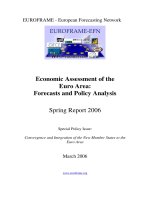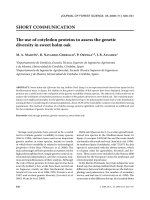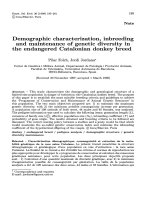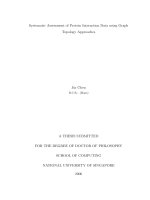Assessment of genetic diversity in thirty-five genotypes of oilseed brassica species using principal component analysis
Bạn đang xem bản rút gọn của tài liệu. Xem và tải ngay bản đầy đủ của tài liệu tại đây (238.87 KB, 9 trang )
Int.J.Curr.Microbiol.App.Sci (2019) 8(1): 378-386
International Journal of Current Microbiology and Applied Sciences
ISSN: 2319-7706 Volume 8 Number 01 (2019)
Journal homepage:
Original Research Article
/>
Assessment of Genetic Diversity in Thirty-Five Genotypes of Oilseed
Brassica Species using Principal Component Analysis
M.C. Gupta1*, A.K. Sharma1, A.K. Singh1, Himadri Shekhar Roy2 and
Sudhir Singh Bhadauria3
1
Department of Plant Breeding & Genetics, College of Agriculture, Gwalior-474002 (MP),
India
2
Department of Statistical Genetics, IASRI, Library Avenue, Pusa, New Delhi-110012, India
3
Department of Agronomy, College of Agriculture, Gwalior-474002 (MP), India
*Corresponding author
ABSTRACT
Keywords
Principal
component, Cluster,
Genotypes,
variable, Brassica
Article Info
Accepted:
04 December 2018
Available Online:
10 January 2019
The principal component and factor analyses of 35 genotypes of different Brassica species
was carried for pooled data of two years 2015-16 and 2016-17. The PCA indicated that
first four principal components showed eigen values more than one and explained more
than 80% of total variability in pooled analysis. Based on Varimax Rotation all fourteen
characters were grouped in eight principal factors and siliquae per plant, plant height, main
shoot length and siliquae on main shoot were the major contributing traits which accounted
for 69.33% of total variation of 82.46%. The hierarchical cluster analysis divided 35
genotypes into six clusters. The cluster IV appeared as the largest cluster containing
maximum numbers of genotypes 23 under pooled analysis. The mean performance of
different clusters revealed wide range of differences among clusters. The genotypes V20
(GPM-O-1 X PT-303), V16 (PL-58 X BN-11), V27 (GPM-O-58), V5 (NGM-17 X T-42)
and V15 (PL-58 X BN-10) in cluster IV showed very good performance for seed & oil
yield per plant. While genotypes V11 (T-42 X NGM-17), V10 (T-42 X GPM-O-58), V19
(T-42 X PL-58) and V33 (T-42) in cluster III, IV and V exhibited very good performance
for oil content.
Introduction
Rapeseed-mustard is the second most
important edible oilseed crop in India after
Soybean. It contributes about 23 % and 25 %
in the total oilseed area and production,
respectively. It is grown over an area of 6.5
million ha with production and productivity of
7.28 million tons and 1128 kg/ha, respectively
(Anonymous, 2015). Most of the mustard
cultivars have very narrow genetic base which
limits their further crop improvement. Genetic
variability in respect to genetic diversity is the
prerequisite for the crop improvement.
Genetic diversity arises either due to
geographical separation or due to genetic
barriers to cross ability. The interspecific
hybridization also could be one way to create
378
Int.J.Curr.Microbiol.App.Sci (2019) 8(1): 378-386
genetic variability and broaden the genetic
base. The quantification of genetic diversity
by biometrical approaches can help in
choosing diverse parents for a successful
breeding
programme.
The
principal
component and factor analysis is an important
tool for the assessment of genetic divergence
among the genotypes and to assess the relative
contribution of particular trait to the total
variability. It also helps in identifying most
relevant characters by explaining the total
variation in the original set of variables with
as few of the components as possible and
reduces the complexity or dimension of the
problem (Zaman et al., 2010). Thus, keeping
all this in view, the present research work was
planned to determine the importance of traits
associated with seed and oil yield along with
their inter-relationship and to cluster them
using PCA analysis for all 35 genotypes of
different oilseed Brassica species comprising
20 F2s/F3s populations (designated as V1 to
V20) and 15 parents (designated as V21 to
V35).
Materials and Methods
The experimental material comprised of 20
segregating populations (F2s / F3s) and 15
parents (Nine B. juncea lines, two B.
napuslines, one line each of B. rapa var toria,
B. rapa var. yellow sarson, B. carinata and B.
nigra) Table 1. These genotypes represented a
very wide range of diversity available in the
respective
species.
The
segregating
populations were derived by attempting
interspecific crosses during rabi 2013-14. F1s
thus produced were planted during 2014-15.
Colchicine treatment was given to sterile
interspecific F1s. The F1s were selfed to
develop F2 populations during rabi 2014-15.
The F2s were selfed to develop F3s population.
Twenty F2s/ F3s population along with fifteen
parents were evaluated for two consecutive
years Rabi 2015-16 and 2016-17 at research
field, College of Agriculture Gwalior (MP)
India. The experiments were laid out in
randomized block design with two replications
at spacing of 45 X 15 cm in paired rows. Ten
plants from parent and 40 plants from F2s/ F3s
were selected randomly for recording of
various observations. Data for different
agronomic and qualitative traits viz. days to
50% flowering (DF), plant height (PH), nos.
of primary branches per plant (PB), nos. of
secondary branches per plant (SB), main shoot
length (MSL), siliquae on main shoot
(SOMS), siliquae per plant (SPP), siliqua
length (SL), seeds per siliqua (SPS), test
weight (TW), days to maturity (DM), seed
yield per plant (SYPP), oil content (OC) and
oil yield per plant (OYPP) were recorded from
randomly selected plants.
Statistical analysis
Principal factor and cluster analyses were
performed using SPSS 10.0. Principal factor
analysis was carried out using principal
component method for factor extraction. The
principal components (PCs) with eigen roots
more than one were retained. As the initial
factor loadings were not clearly interpretable,
the factor axes were rotated using Varimax
rotation. The correlation values >0.5 between
the traits and the principal components were
considered for construing the relationship
between the traits, and the principal Factor
(PF). Principal factor scores were calculated
using Anderson-Rubin method. Scatter plots
were drawn using two main Principal factors
in order to identify the most distinct and useful
accessions with desirable traits in different
clusters. Unweighted Pair-Group Method
using Arithmetic Averages Method (UPGMA)
of hierarchical cluster analysis was utilized
with city block distances to classify all 35
genotypes
For studying different genetic parameters and
inter-relationships, fourteen characters were
taken into consideration from the randomly
379
Int.J.Curr.Microbiol.App.Sci (2019) 8(1): 378-386
selected 10 plants in parents and 40 plants in
segregating population both years 2015-16
and 2016-17. Mean data of each character was
estimated and pooled data of two years (201516 and 2016-17) was subjected to Principal
Component Analysis (PCA).
Results and Discussion
Eigen values and percent variance
Principal component analysis indicated that
only first four principal components (PCs)
showed eigen values more than one and they
cumulatively explained 82.46% of the total
variability. The first PC (PC1) explained
36.69% of the total variation and the
remaining three principal components
explained 17.82, 14.83 and 13.13 variation,
respectively (Table 2). The first one absorbed
and accounted for maximum proportion of
total variability in the set of all PCs and the
remaining ones accounted for progressively
lesser and lesser amount of variation.
Factor loadings of characters with respect
to principal factors (Varimax rotation)
The analysis without rotation of axes could
not load all the variables which indicated that
it didn’t offer much information regarding the
idea of correlation between the variables and
the principal components. The Varimax
rotation, thus applied, resulted in loading of all
the variables on different principal
components. Factors’ loadings of different
variables are presented in Table 3. All
fourteen variables showed high loadings on
different principal factors, and none was left
after rotation of the principal factor axes.
The first principal factor (PF-1) ascribed for
number of siliquae per plant and it was
designated as siliqua factor. The PF-2 had
high loading for plant height and designated as
height factor. Factor-3 had high loadings for
two variables i.e. main shoot length and
number of siliquae on main shoot, this factor
was designated as main shoot factor. The PF-4
was named as siliqua and seed factor as two
variables viz. number of siliquae on main
shoot and seeds per siliqua were loaded on this
factor. Variables seed per siliqua, siliquae on
main shoot and seed yield plant were loaded
on the principle factor- 5, hence it was
designated as seeds factor. PF-6 was
designated as maturity factor as variables viz.
days to 50%, flowering and days to maturity
were loaded on this factor. Two variables viz.
seed yield per plant and secondary branch
were loaded on the principle factor- 7 hence it
was designated as seed yield factor. The PF-8
had high loadings on variables secondary
branches and seeds per siliqua and designated
as branching factor.
Clustering pattern based on UPGMA
method
Unweighted Pair-Group Method using
Arithmetic
Averages
(UPGMA)
of
hierarchical cluster analysis was utilized with
city block distances to classify the thirty-five
genotypes into six clusters containing one to
twenty-three genotypes.
The UPGMA method in hierarchical cluster
analysis grouped 35 genotypes into six
clusters (C), Table 4. Maximum number of
genotypes i.e. 23 was grouped in Cluster IV
(CIV). Four genotypes were grouped each in
cluster I (CI) and cluster V (CV). Two
genotypes were present in cluster III.
Whereas, one genotype each was grouped in
clusters CII and CVI.
Cluster means and general means of
different characters
The cluster means and general means for
various characters under pooled analysis have
been presented in Table 5. The comparison of
380
Int.J.Curr.Microbiol.App.Sci (2019) 8(1): 378-386
cluster means revealed that Cluster IV had the
highest mean values for eight characters viz.,
secondary branch (10.41), main shoot length
(70.62), siliquae on main shoot (52.96),
siliquae per plant (320.31), test weight (5.41),
seed yield per plant (16.02), oil content
(39.29) and oil yield per plant (6.28). This
cluster was able to lead in respect of the
highest cluster mean values for maximum
characters. Among 14 characters, this cluster
stood first for 8 characters.
The cluster II obtained the highest cluster
mean value for six characters viz., days to 50%
flowering (41.25), primary branch (6.45),
secondary branch (12.35), siliqua on main
shoot (72.60), siliquae per plant (327.72) and
days to maturity (135.50 days). Cluster V also
showed highest mean values for different 6
characters viz. days to 50% flowering (39.31
days), plant height (122.58 cm), primary
branch (6.84), siliqua length (6.53 cm), seeds
per siliqua (36.94), and oil content (43.52%).
The cluster I showed highest mean values for
three characters viz. days to 50% flowering
(36.94 days), plant height (111.27 cm) and
days to maturity (131.56 days). Cluster III
observed highest loading for three characters
plant height (170.51 cm), siliqua length (5.59
cm) and seeds per siliqua (19.23) while cluster
VI also showed highest loading for variables
primary branch (9.93) and secondary branch
(24.23).
Principal component analysis indicated that
only first four principal components (PCs)
showed eigen values more than one and they
cumulatively explained more than 80% of the
total variability under pooled study. The first
principal component absorbed and accounted
for maximum proportion of total variability in
the set of all PCs and the remaining ones
accounted for progressively lesser and lesser
amount of variation. Similar results have also
been reported earlier by Zada et al., (2013),
Avtar et al., (2014, 2017), Ray et al., (2014),
Neeru et al., (2015) and Verma et al., (2016).
The Varimax Rotation was applied to estimate
correlation between the variables and the
principal components. This resulted in loading
of all the variables on different principal
components.
Based on similarities of variables all fourteen
characters have been grouped in eight
principal factors viz. siliquae per plant factor,
height factor, main shoot factor, siliqua factor,
seed per siliqua factor, maturity factor, seed
yield factor and branching factor. Similar
results were reported by Singh et al., (2010),
Zada et al., (2013), Neeru et al., (2015) and
Avtar et al., (2017). Such a grouping of
similar type of variables having loaded on a
common principal factor elaborates the
successful
transformation
of
fourteen
interrelated variables into eight independent
principal factors explaining 82.46% of the
variability of the original set under pooled
analysis.
It was observed from analysis that siliquae per
plant, plant height, main shoot length and nos.
of siliquae on main shoot were the major
distinct variability contributing traits and
accounted for 69.33% of the total variation.
Thus, the successful transformation of
fourteen morphological variables into four
independent principal factors by means of
grouping of similar type of variables on
different principal factors elaborated and
explained. These findings were in tune with
those obtained by Neeru et al., (2015) in
Indian mustard. The UPGMA method with
City Block distances in hierarchical cluster
analysis has divided the thirty-five genotypes
into six clusters (C). The cluster IV appeared
as the largest cluster containing maximum
numbers of genotypes 22 and 23 under pooled
analysis. The numbers of genotypes in clusters
I, II, III, V and VI were 4, 1, 2, 4 and 1,
respectively.
381
Int.J.Curr.Microbiol.App.Sci (2019) 8(1): 378-386
Table.1 List of F2s/F3s population and parents used in research experiment
Genotype
V1
V2
V3
V4
V5
V6
V7
V8
V9
V10
V11
V12
V13
V14
V15
V16
V17
V18
V19
V20
V21
V22
V23
V24
V25
V26
V27
V28
V29
V30
V31
V32
V33
V34
V35
Pedigree
NGM-43 X PT-303
NGM-17 X PT-303
KM-11 X T-42
NGM-6 X T-42
NGM-17 X T-42
PL-58 X PT-303
PT-303 X GPM-O-5
(PT-303XGPM-O-5) X GPM-O-5
Genomic constitution
B. juncea x B. rapa var toria
B. juncea x B. rapa var toria
B. juncea x B. rapa var yellow sarson
B. juncea x B. rapa var yellow sarson
B. juncea x B. rapa var yellow sarson
B. juncea x B. rapa var toria
B. rapa var toria x B. juncea
(B. rapa var toria x B. juncea) x B. juncea
PT303 X GPM-O-5
T-42 X GPM-O-58
T-42 X NGM-17
PT-303 X B. nigra
PL-6 X BN-11
PL-6 X BN-10
PL-58 X BN-10
PL-58 X BN-11
BN-11 X PL-6
KM-11 X CRP-09
T-42 X PL-58
GPM-O-1 X PT-303
NGM-43
NGM-17
KM-11
NGM-6
PL-58
GPM-O-5
GPM-O-58
PL-6
GPM-O-1
BN-10
BN-11
PT-303
T-42
CRP-09
Banarasi Rai
B. rapa var toria x B. juncea
B. rapa var yellow sarson x B. juncea
B. rapa var yellow sarson x B. juncea
B. rapa var toria x B. nigra
B. juncea x B. napus
B. juncea x B. napus
B. juncea x B. napus
B. juncea x B. napus
B. napus x B. juncea
B. juncea x B. carinata
B. rapa var yellow sarson x B. juncea
B. juncea x B. rapa var toria
B. juncea
B. juncea
B. juncea
B. juncea
B. juncea
B. juncea
B. juncea
B. juncea
B. juncea
B. napus
B. napus
B. rapa var toria
B. rapa var yellow sarson
B. carinata
B. nigra
382
Int.J.Curr.Microbiol.App.Sci (2019) 8(1): 378-386
Table.2 Total variance explained by different principal component among 20 F2s/F3s populations
and 15 parents of different Brassica species for pooled of years 2015-16 and 2016-17
Principal
component
1
2
3
4
5
6
7
8
9
10
11
12
13
14
Eigen value
Per cent
variance
36.68
17.82
14.83
13.13
5.46
2.99
2.96
2.24
1.29
1.06
0.79
0.49
0.26
0.00
5.135
2.495
2.076
1.838
0.765
0.418
0.415
0.314
0.180
0.149
0.111
0.068
0.036
0.000
Per cent cumulative
variance
36.68
54.50
69.33
82.46
87.92
90.91
93.87
96.11
97.40
98.46
99.25
99.74
100.00
100.00
Percent variation explained by first four components = 82.46
First 4 principal component scores were used for clustering purpose
Table.3 Factor loadings of characters with respect to different principal factors (Varimax
rotation) in 35 genotypes of different Brassica species
Trait
Days
to
50%
flowering
Plant
height
Primary branch
Secondary branch
Main shoot length
Siliquae on main
shoot
Siliquae per plant
Siliqua length
Seeds per siliqua
Test weight
Days to maturity
Seed yield per
plant
Oil
content
Oil yield per plant
PF-1
0.004
0.133
-0.000
0.023
0.030
0.033
0.988*
-0.004
-0.041
0.001
0.008
0.033
-0.008
-0.006
PF-2
0.093
0.967*
-0.008
0.022
0.124
0.102
-0.142
-0.005
-0.067
0.014
0.066
0.012
-0.003
-0.004
PF-3
-0.158
-0.124
-0.062
-0.130
0.739*
0.576*
-0.205
0.002
0.006
0.011
-0.238
0.041
0.047
-0.009
383
PF-4
0.053
0.029
-0.282
-0.122
0.529*
-0.703
0.018
0.079
0.372
0.071
0.026
0.123
0.167
0.109
PF-5
0.085
0.046
0.067
-0.170
-0.282
0.356
0.021
0.056
0.805*
0.016
0.078
0.233
0.181
0.078
PF-6
0.478
-0.157
0.053
0.109
0.229
0.161
-0.015
0.033
-0.098
0.014
0.778*
0.104
-0.142
0.085
PF-7
-0.462
0.006
0.176
0.460
-0.002
-0.012
-0.036
0.010
-0.108
0.097
0.120
0.702*
0.116
0.02
PF-8
0.126
-0.008
0.178
0.803*
0.125
0.034
0.004
0.037
0.310
-0.076
-0.173
-0.389
-0.065
0.041
Int.J.Curr.Microbiol.App.Sci (2019) 8(1): 378-386
Table.4 Clustering pattern of 20 F2s/F3s populations and 15 parents of different Brassica species
during under pooled analysis
Cluster
Parents/population
Nos of
lines
CI
V3 (KM-11XT-42), V18 (KM-11X B. carinata), V23 (KM-11), V32 (PT-303),
4
CII
V35 (B. nigra)
1
CIII
V28 (BN-10), V30 (BN-11),
2
CIV
V1 (NGM-43XPT-3-03), V2 (NGM-17XPT-303), V4 (NGM-6XT-42), V5 (NGM17XT-42), V6 (PL-58XPT-303), V7 (PT-303XGPM-O-5), V8 ((PT-303XGPM-O5) X GPM-O-5), V9 (PT-303XGPM-O-5), V12 (PT-303 X B. nigra), V13 (PL6XBN-11), V14 (PL-6XBN-10), V15 (PL-58XBN-10), V16 (PL-58XBN-11), V17
(BN-11XPL-6), V20 (GPM-O-1-1XPT-303), V21 (NGM-43), V22 (NGM-17),
V24 (NGM-6), V25 (PL-58), V26 (GPM-O-5), V27 (GPM-O-58), V29 (PL-6),
V31 (GPM-O-1)
23
CV
V10 (T-42XGPM-O-58), V11 (T-42XNGM-17), V19 (T-42XPL-58), V33 (T-42)
4
CVI
V34 (B. carinata)
1
Table.5 Cluster means vs general means for various characters in 20 F2s/F3s populations and 15
parents of different Brassica species for pooled of two years
Characters
Cluster-1
Cluster-2
Cluster-3
Cluster-4
Cluster-5
Cluster-6
36.94
41.25
51.25
44.13
39.31
55.00
General
mean
43.39
111.27
185.73
170.51
193.52
122.58
223.11
175.32
primary
5.24
6.45
4.12
5.23
6.84
9.93
5.52
Nos of secondary
branches
9.41
12.35
4.10
10.41
3.61
24.23
9.61
Main shoot length
57.55
52.96
60.37
70.62
53.40
44.20
65.32
Siliquae
shoot
40.71
72.60
43.85
52.96
40.54
37.25
49.73
Siliquae per plant
244.52
327.72
172.50
320.31
119.15
242.52
278.20
Siliqua length
Seeds per siliqua
4.98
15.16
1.25
4.82
5.59
19.23
4.91
14.80
6.53
36.94
4.98
12.52
5.04
17.28
Test weight
Days to maturity
Seed yield per plant
Oil content
Oil yield per plant
3.73
131.56
9.98
36.46
3.64
1.17
135.50
8.88
33.83
3.00
4.03
137.38
7.01
38.86
2.72
5.41
136.39
16.02
39.29
6.28
4.52
132.62
9.84
43.52
4.30
4.60
150.00
12.20
35.50
4.32
4.89
135.83
13.79
39.16
5.40
Days
to
flowering
50%
Plant height
Nos
of
branches
on
main
384
Int.J.Curr.Microbiol.App.Sci (2019) 8(1): 378-386
This analysis further showed that some of the
genotypes belonging to various interspecific
populations (F3/F2) and their parents were
grouped into the same cluster, while many
others fell into different clusters. This
clustering pattern suggests that interspecific
diversity does not necessarily represent
genetic diversity; this might be due to free
exchange of genetic material among different
species and also due to natural and artificial
selection forces resulting in perpetuation and
stabilization of similar genotypes. These
results were in agreement with the results
reported earlier by Budhanwar et al., (2010),
Belete et al., (2011), and Singh (2012),
Doddabhimappa et al., (2010), Singh (2012),
Neeru et al., (2015) and Avtar et al., (2017).
material. All the 35 genotypes (20 F3s/F2s
population and 15 parents) have been
successfully classified into six clusters and all
the variables have been reduced to only eight
principal factors. Based on mean performance
of different clusters for different traits the
genotypes V20 (GPM-O-1 X PT-303), V16
(PL-58 X BN-11), V27 (GPM-O-58), V5
(NGM-17 X T-42) and V15 (PL-58 X BN-10)
were having high seed yield per plant and
yield contributing components. The genotypes
with superior oil content were V11 (T-42 X
NGM-17), V10 (T-42 X GPM-O-58), V19
(T-42 X PL-58) and V33 (T-42) which can be
utilized for evolving mustard varieties with
high seed yield and oil content.
Acknowledgement
In the present study, the mean performance of
different clusters revealed wide range of
differences among clusters (Table 5). The
genotypes V20 (GPM-O-1 X PT-303), V16
(PL-58 X BN-11), V27 (GPM-O-58), V5
(NGM-17 X T-42) and V15 (PL-58 X BN-10)
in cluster IV showed very good performance
for seed and oil yield per plant due to
possession of more numbers of siliquae per
plant, long main shoot length, more siliquae
on main shoot, more seeds per siliqua and
higher test weight. While genotypes V11 (T42 X NGM-17), V10 (T-42 X GPM-O-58)
and V19 (T-42 X PL-58)in cluster III and
IV& V33 (T-42)in cluster V, respectively
exhibited very good performance for oil
content and could be used as donor for the
introgression of high oil content. Alemayehu
and Becker (2002) found that both principal
component and cluster analyses disclosed
complex relationships among the Ethiopian
mustard (Brassica carinata A. Braun)
accessions and characters. Similar results
were reported by Singh (2012), Zaman et al.,
(2010), Singh et al., (2010), Avtar et al.,
(2017) and Nerru et al., (2015).
We gratefully acknowledge support received
from the College of Agriculture Gwalior
(MP) for carrying out this study. We are also
thankful to Rasi Seeds for providing source
materials for experiment.
References
Alemayehu Nigussie and Becker Heiko
(2002). Genotypic diversity and
patterns of variation in a germplasm
material of Ethiopian mustard
(Brassica carinata A. Braun). Genetic
Resources and Crop Evolution49:
573-582.
Avtar R, Manmohan, MinakshiJattan, Babita
Rani, Nisha Kumari, N. K. Thakral
and R. K. Sheoran (2017). Evaluation
and diversity analysis in Indian
mustard [Brassica juncea (L.)
Czern&Coss.] germplasm accessions
on the basis of principal component
analysis. Journal of Applied and
Natural Science 9(4): 2485 – 2490.
Avtar, R., Singh, D., Thakral, N.K., Singh,
A., Sangwan, O., Rani, B. and
Kumari, N. (2014). Multivariate
The results of this study concluded that the
sufficient variability was existed in the
385
Int.J.Curr.Microbiol.App.Sci (2019) 8(1): 378-386
analysis
for
evaluation
and
classification of toria germplasm
accessions. Res. Crops 15(1): 129134.
Belete YS, Kebede SA and Gemelal AW.
2011. Multivariate analysis of genetic
divergence among Ethiopian mustard
(Brassica
carinata
A.
Braun)
genotypes in relation to seed oil
quality traits. Intern J Agric Res 6:
494 – 503.
Budhanwar PD, Kalamkar, Beena Nair,
Vandana and Fulkar PI. 2010.
Evaluation of recombinant lines for
genetic potential and genetic diversity
for yield contributing characters in
mustard [B. juncea (L.) Czern&Coss.].
Advances in Plant Sci 23: 227-229.
Doddabhimappa, R., Gangapur, B., Prakash,
G. and Hiremath, C. P. (2010).
Genetic Diversity analysis of Indian
mustard (Brassica juncea L.) Electro.
J. Plant Breed. 1(4): 407-413.
Neeru, Thakral, N. K., Avtar R., and Singh A.
(2015). Evalu-ation and classification
of Indian mustard (Brassica juncea L.)
genotypes using principal component
analysis. J. Oilseed Brassica 6(1),
167-174.
Romesburg, H.C. (1984). Cluster Analysis for
Researchers. Krieger Publishing Co.,
Malabar, Florida.
Rray K, J. Dutta, H. Banerjee, R. Biswas, A.
Phonglosa and A. Pari (2014).
Identification of principal yield
attributing traits of Indian Mustard
[Brassica juncea (L.) Czernj and
Cosson] using multivariate analysis.
The Bioscan 9(2):803-809
Singh D, Arya RK, Chandra N, Niwas R and
Salisbury P. 2010. Genetic diversity
studies in relation to seed yield and its
component traits in Indian mustard
[Brassica juncea (L) Czern&Coss.]. J
Oilseed Brassica 1: 19-22.
Singh, B. (2012). Genetic divergence in elite
genotypes of Indian mustard (Brassica
juncea L.). M.Sc. Thesis; CCS HAU,
Hisar.
Verma Urmil, N. K. Thakral and Neeru
(2016): Genetic Diversity Analysis in
Indian Mustard [Brassica Juncea (L.)
Czern&Coss.]. International Journal of
Applied Mathematics & Statistical
Sciences (IJAMSS) Vol. 5, Issue 1
Zada, M., Zakir, N., Rabbani, M., Shinwari,
A. and Khan, Z. (2013). Assessment
of genetic diversity in Ethiopian
mustard (Brassica carinata A. Brun)
germplasm
using
multivariate
techniques. Pak. J. Bot. 45(SI): 583593.
Zaman, M. A., Khatun, M. T., Ullah, M. Z.,
Moniruzzamn, M. and Rahman, M. Z.
(2010). Multivariate analysis of
divergence in advanced lines of
mustard (Brassica spp) Bangladesh
Journal of Plant Breeding Genet.
23(2):29-34.
How to cite this article:
Gupta, M.C., A.K. Sharma, A.K. Singh, Himadri Shekhar Roy and Sudhir Singh Bhadauria.
2019. Assessment of Genetic Diversity in Thirty-Five Genotypes of Oilseed Brassica Species
using Principal Component Analysis. Int.J.Curr.Microbiol.App.Sci. 8(01): 378-386.
doi: />
386









